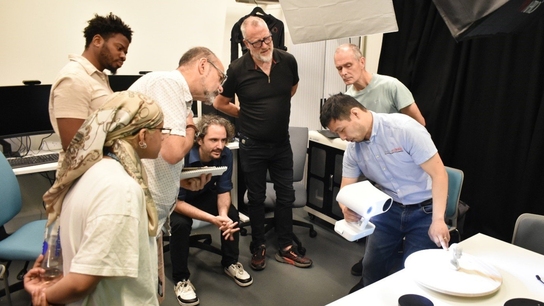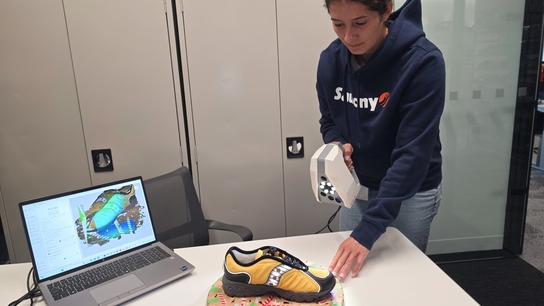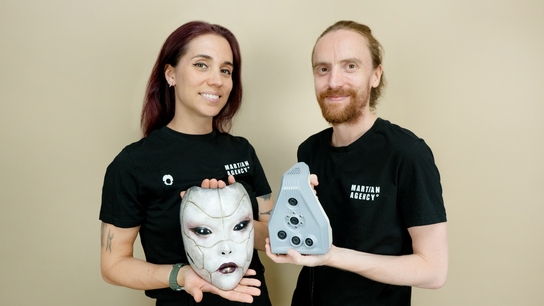3D scanning a giant 66-million-year-old T-Rex skeleton
The Goal: To scan in color 3D all the bones of the massive dinosaur in precise detail, from head to tail, including the tiniest bones, some only millimeters in size.
Tools Used: Artec Eva, Artec Studio
Valentin Vanhecke of the Dutch company 4Visualization has scanned the astonishingly well-preserved skeleton of a giant dinosaur that lived 66 million years ago. The newly mounted skeleton is now on display at a local museum.
The discovery of the skeleton of Tyrannosaurus rex, dubbed Trix, in 2013 in Montana, U.S., was staggering news for the paleontological community: more than 80% of the bone volume was preserved, which placed Trix in the top 3 most complete Tyrannosaurus rex skeletons ever found. All essential, larger bones were present, and the quality of the fossil was unmatched by any other T.Rex skeletons in the world.
The bones were uncovered by the staff of Naturalis Biodiversity Center based in Leiden, the Netherlands, which is where the skeleton has gone on display. In order to prepare it for exhibiting, the center contracted Valentin Vanhecke, the founder and owner of 3D scanning service provider 4Visualization. Valentin’s job was to scan the overall fossil and separate bones on site. The 3D models were later used to mount the entire skeleton: the missing bones were modeled, 3D printed and placed where they belonged.
Valentin made two trips to the Black Hills Institute in South Dakota, U.S. where the bones of Trix were prepared for scanning. The scanning was performed with Artec Eva 3D object scanner, which was supplied by Artec’s Gold Partner 4C Creative CAD CAM Consultants.


Valentin Vanhecke scanning the skeleton of T.Rex
“This was great,” says Valentin. “Everything was done with the Eva, only the very last two of the tail vertebrae, which are only a few cm long… I managed to do them but they were really on the limit of the smallest size possible. On the other end is the skull, which is nearly 2m long and has a lot of detail, pathology and hollow spaces, like the eye sockets and all of the nasal passages.”

The cranium of T.Rex in Artec Studio 11
In the skull, a small bone was found for the first time ever that leads from the outer ear toward the inner ear. The bone is a 3-4mm high ridge that is nearly 1mm thick and 5cm long. Despite the small size, the bone was effectively captured by the scanner.
The smaller bones took two weeks to scan and the overall fossil took one day. The bones were scanned with the resolution of around 0.3mm.

This bone is part of the lower jaw of the T.Rex. The round holes were made by the teeth of another dinosaur. The wounds were nowhere near fatal as they healed perfectly.
“Then came the post-processing for all those bones which I did in my office, which was done mostly in the off-time in my company,” says Valentin. “This left me with a box of about 200 puzzle pieces without the picture on the front of the box.”
Valentin performed smooth fusion of all the bones in Artec Studio 11 3D scanner software with the resolution of 0.3 or 0.5 mm depending on the size of the bone or the detail. The size of the files ranged from 200 Mb to 1,000 Mb. Valentin decimated the meshes and loaded them in one project with the overall scans of the complete skeleton.

Putting together the scans of the cranium, vertebrae and ribs in Artec Studio 11
Where possible the missing bones of the T.Rex were mirrored and printed out. Mirroring was performed in Meshmixer, where some color was added as well, after the printing was done.
“When a bone was missing from our T.Rex, I used casts of other specimens,” says Valentin. “The feet for instance came from another T.Rex Sue and some of the missing vertebrae came from Stan. The right leg was found complete but the left one was missing so now Trix ‘walks around’ on two right legs.”
All the missing bones were printed using Ultimaker 3D printers. When the whole skeleton was in place, Valentin made several more scans of T.Rex to know exactly how to put all the pieces where they belonged.

The complete skeleton of the T.Rex in 3D
“Putting the puzzle together was a tedious job as the skeleton is about 13 meters long from the tip of the nose to the end of the tail,” says Valentin. “At first I hoped to do it with all the bones in the high resolution that I had scanned them but that was too much for my computer, so I had to simplify all the bones to keep the total size workable.”
Then the file had to be simplified again to put it online and make it viewable by average computers. The model was featured on Dutch national television in the “Expeditie T.Rex” film and can be viewed on the 4Visualization page on Sketchfab.
Scanners behind the story
Try out the world's leading handheld 3D scanners.





